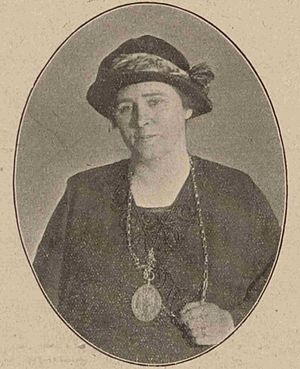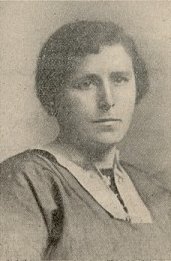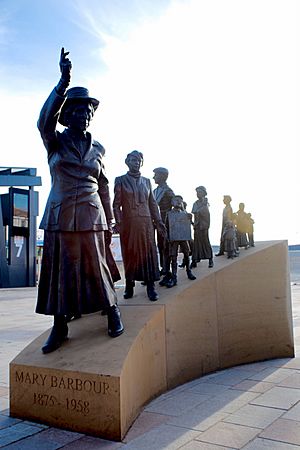Mary Barbour facts for kids
Quick facts for kids
Mary Barbour
|
|
|---|---|
 |
|
| Born |
Mary Rough
20 February 1875 Kilbarchan, Scotland
|
| Died | 2 April 1958 (aged 83) Southern General Hospital, Glasgow, Scotland
|
| Nationality | Scottish |
| Occupation | Political activist, local councillor, bailie, magistrate |
| Known for | Glasgow rent strikes, Women's Peace Crusade |
| Spouse(s) | David Barbour (m. 1896–1957) |
| Children | David (1897–1897) James William |
Mary Barbour (née Rough; 20 February 1875 – 2 April 1958) was a Scottish political activist, local councillor, bailie and magistrate. Barbour was closely associated with the Red Clydeside movement in the early 20th century and especially for her role as the main organiser of the women of Govan who took part in the rent strikes of 1915.
Contents
Life
Barbour was born on 20 February 1875 at 37 New Street, Kilbarchan to Jean (Gavin) and James Rough, a handloom carpet weaver. She was the third of seven children. Barbour attended school until she was fourteen years old. In 1887, the family moved to the village of Elderslie and Barbour worked as a thread twister, eventually becoming a carpet printer. On 28 August 1896, Mary Rough married an engineer, David Barbour (2 May 1873 – 13 November 1957), at Wallace Place, Elderslie. By the 1901 census, the couple had settled in Govan at 5 Macleod Street, where they lived with their son, James. Their son David died in infancy in 1897. By the 1911 census, the family, including another son, William, had moved to 43 Ure Street (now Uist Street).
In 1933, Barbour moved to a council house at 34 Cromdale Street in Drumoyne, Glasgow, where she lived until her death. One year after she was widowed, Barbour died at age 83 in the Southern General Hospital, Glasgow. Her funeral was held at Craigton Crematorium in Cardonald, near Govan.
Political activism
Barbour first became politically active, joining and becoming an active member of the Kinning Park Co-operative Guild. Barbour's political activism began in earnest in leading the South Govan Women's Housing Association during the Glasgow rent strikes of 1915, when she actively organised tenant committees and eviction resistance. The protestors became known as "Mrs Barbour's Army", and included Agnes Dollan, Helen Crawfurd, Mary Burns Laird, and Mary Jeff.
Women's Peace Crusade
Barbour was a founder of the Women's Peace Crusade (WPC) at the "Great Women's Peace Conference" in June 1916, with Helen Crawfurd and Agnes Dollan. These women also worked with Agnes Harben and others across Britain.
The WPC campaigned throughout June and July 1916 for a negotiated settlement to World War I. Barbour and the others organised this predominately through open air meetings in Glasgow, Clydeside and Edinburgh. The possibility of a negotiated peace settlement became less likely with the formation of a new coalition government in December 1916, led by Lloyd George.
Both the Russian Revolution and the Irish Easter Rising provided a catalyst for renewed peace activism in Scotland, including the work of the WPC. The 1917 annual May Day celebration in Glasgow Green brought together 70,000 people. Women peace activists, including Barbour, Dollan and Mary Burns Laird, were prominent among the speakers. This type of activity inspired the re-launch of the Women's Peace Crusade in July 1917, on Glasgow Green with 10,000 people taking part. Other branches of the WPC were then established throughout Scotland, England and South Wales. Their campaign continued until the end of World War I.
Political career
In 1920, Barbour stood as the Labour candidate for Fairfield ward in Govan, and was elected to Glasgow Town Council, becoming the one of the city's first woman councillors. While Barbour has often been credited as being 'the first Labour woman councillor in Glasgow', this is not the case. Barbour was one of a pioneering group of five women who were elected in 1920 which included Eleanor Stewart (Maryhill) as the other Labour woman councillor, and Jessica Baird-Smith, Mary Bell and Mary Anderson Snodgrass all respectively elected as Moderate councillors. It would appear that the misconception about Barbour being the "first Labour woman councillor" originated in Patrick Dollan's book about the Kinning Park Co-operative Society, published in 1923. While standing for election, Barbour stated that "the advent of a woman candidate was seen by some men and women as outrageous", but contended that women councillors were needed to tackle issues that affected women and children.
From 1924–27 Barbour served as one of Glasgow Corporation's first woman baillies, alongside Mary Bell. Barbour was appointed as one of the first woman magistrates in Glasgow. Barbour became a Justice of the Peace for the City of Glasgow in January 1928.
Role in provision of health and welfare services
From 1925, Barbour was Chair of the Glasgow Women's Welfare and Advisory Clinic, and had worked with the Glasgow Corporation's specialist in child and female healthcare, Dr Nora Wattie, to establish the clinic, manned by female nurses and doctors. ..... The clinic subsequently moved to 123 Montrose Street, Glasgow during 1932.
In November 1926, Barbour attended the opening of the West Govan Child Welfare Clinic. This building, at 20 Arklet Street, Govan, remains in use by NHS Greater Glasgow and Clyde as Elderpark Clinic.
During her tenure as a councillor and Bailie, Barbour worked relentlessly on behalf of the working class people of her constituency, serving on numerous committees covering the provision of health and welfare services, and even after her retirement in 1931, Barbour remained involved in this area.
Influence and recognition
Statue
In 2011, Glasgow Women's Library commissioned 21 artworks as part of their 21st anniversary celebrations. Glasgow-based artist Sharon Thomas chose to depict a hypothetical monument to Barbour in Govan. The work generated interest in a real statue of Barbour, which in 2013 led to the creation of the Remember Mary Barbour Association (RMBA), who campaigned for a statue. The campaign garnered support from Glasgow City Council, Nicola Sturgeon, the Scottish Parliament and Sir Alex Ferguson.
In September 2015 five sculptors were shortlisted to produce a maquette to convey their vision of a fitting statue. Public showings of the set of five maquettes were scheduled to take place from November 2015 through February 2016, at various locations commencing at the Pearce Institute in Govan. Sculptor Andrew Brown was selected to sculpt the statue in February 2016.
Although having secured about £56,000 through public donations, approximately half of the funding needed to build the statue, the RMBA's application to Creative Scotland was rejected in November 2015 based on an apparent lack of community engagement. In order to meet the shortfall and raise the money to complete the project, the RMBA planned several events including a gala concert to be held in the Old Fruitmarket in Glasgow.
The statue was completed in 2017 and unveiled in March 2018.
The Kilbarchan Cairn
In May 2015, Renfrewshire Council agreed to fund a commemorative cairn in Barbour's home village of Kilbarchan. The Council estimated the cost of the cairn to be £6,000 which was funded from the Renfrewshire Citizens Fund following a recommendation from the council’s Johnstone and the Villages Local Area Committee. The cairn was installed in New St, where Barbour was born, and was unveiled on 21 November 2015 by the Provost of Renfrewshire, Anne Hall, in the presence of Barbour's descendants.
Renfrewshire Council also agreed to establish and fund a Mary Barbour Prize to be awarded annually to a school pupil at Kilbarchan Primary School.
Clutha Bar Mural
Mary Barbour is one of two women included in the Clutha Bar mural, and her image is based on the photograph of her in Bailie's robes, c.1924. The Clutha Bar was the site of the Glasgow helicopter crash on 29 November 2013. The mural, coordinated by Art Pistol, features work by a number of artists including Bob McNamara, who is also known as Rogue One, and Danny McDermott, known as EJEK. The mural pays homage to the history of the area, and shows a variety of people who have visited this location.
Blue Plaque in Linthouse
In November 2015, Linthouse Housing Association installed a blue plaque at 10 Hutton Drive, Linthouse, Glasgow to commemorate Mary Barbour and her actions, and those of many other women, during the 1915 Glasgow Rent Strikes. The location references a widely known image from the time of a gathering of people outside the tenement property taking part in a rent strike action.
The text of the plaque describes Barbour as a "Social Reformer, Rent Strike Leader, Women's Peace Crusader and Pioneering Woman Councillor", and incorporates a quote from William Gallacher's book 'Revolt on the Clyde'.














